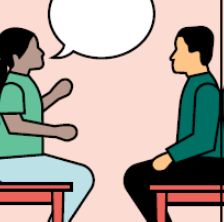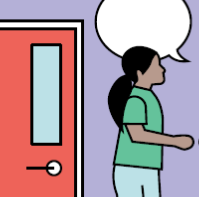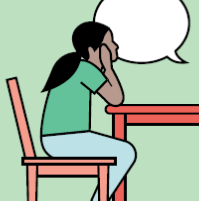Restorative Practice Framework
What
Hester Hornbrook Academy’s vision is to create an inclusive environment where all young people have equal access to education.
Why
Hester Hornbrook Academy is committed to providing a school community that is Safe, Respectful and Productive.
How
Our Restorative Practice Framework forms the foundation of ensuring the community is built and sustained on trusting relationships, and through reparation of relationship rupture.
Restorative Practice is...
Our Restorative Practice Framework involves all individual’s involved in behaviours that disrupt the expectations of Safe, Respectful and Productive, either directly or indirectly to the Hester Hornbrook Academy community. The Restorative Practice Framework upholds Hester Hornbrook Academy’s commitment to child safety and is aligned with staff and student Codes of Conduct, as well as existing policies and procedures. The Restorative Practice is an opportunity for young people to build their awareness of self and others.
Restorative Practice is not…
The Restorative Practice Framework is not a punitive or targeted process. Whilst a young person may be asked to return home and not attend their campus, this is for the purpose of gathering information, structured reflection and preparation of a restorative conversation. Further, it may be to ensure the expectations of Safe, Respectful and Productive behaviours are upheld. Hester Hornbrook places value on the safety and wellbeing of all and believes that learning and wellbeing are a combined concept.
Restorative Response
If there is a behaviour that is displayed that impacts the Hester Hornbrook Academy community in a negative and/or harmful way, and does not align with being Safe, Respectful or Productive, a Hester Hornbrook staff member will have a conversation with the young person directly at the time of it occurring, to acknowledge this. Depending on the nature of what’s
occurred, we will determine whether it is appropriate for onsite learning to continue, or a young person will be supported to go home for the day. This is referred to as the Step In, Step Out, Step Down process. In the instance of a Step Down occurring, the primary contact for the young person will be notified.
| STEP IN |
|
Conversation in the classroom with my classroom team to check in on my wellbeing and needs.
|
| STEP OUT |
|
My behaviour is disruptive. A restorative conversation outside the classroom with my youth worker.
|
| STEP DOWN |
|
My behaviour at school is of concern and I will need to attend a community conference to repair the harm.
|
Restorative Conversations
It is important that every person involved has equal opportunity for their voice to be heard. This extends to the family members and important people in young people’s lives. To support young people to engage in these reflections, Hester Hornbrook Academy uses of the above reflective questions, which can also be prompted within the home, to repair relational issues, and support the development of young people’s awareness of self and others.




Who’s involved?
It is important that every person involved has equal opportunity for their voice to be heard. This extends to the family members and important people in young people’s lives. To support young people to engage in these reflections, Hester Hornbrook Academy uses prompting reflective questions, which can also be prompted within the home, to repair relational issues, and support the development of young people’s awareness of self and others.
|
When talking to someone who has not been SAFE, RESPECTFUL OR PRODUCTIVE:
|
When talking to someone who has been harmed or impacted: |
|
What happened?
|
What did you think when it happened? |
|
What were you thinking at that point?
|
What have thought about since this happened? |
|
What do you think has been impacted by what you did? In what way?
|
How have you been impacted? |
|
Who do you think has been impacted by your actions? In what way?
|
What is needed to make things right? |
|
What can you do now to make things right?
|
How can we make sure this won't occur again? |
|
How can we make sure this won't occur again?
|
Behaviour examples that will have a restorative response
|
Type of incident
|
Examples |
| Unproductive |
Young person is frequently distracting themselves from their set task, impacting on theirs and others productivity.
|
| Disruption |
Young person is continuously disrupting the classroom environment, e.g. leaving class without notifying staff, speaking over others, making loud sounds.
|
| Disrespectful |
Young person is using offensive language, being rude or dismissive towards staff or another student.
|
| Bullying |
Young person who engages in any verbal, physical, and cyber- bullying. Examples would include; name-calling, teasing, language to intentionally offend, antagonising, hitting or inappropriately touching someone, publicising about someone online.
|
| Violence |
Includes physical, verbal and psychological. Examples include; fighting, hitting, pushing, threats, intimidation.
|
| Sexual or Physical Harassment |
Young person exhibitions any unwelcome conduct that makes someone feel offended, humiliated or intimidated.
|
| Ongoing bullying/inappropriate interaction |
Repeated targeting of a student, consistent inappropriate interactions with others (after staff comms), group targeting, and online targeting.
|
| Sexual or physical harassment |
Inappropriate touching, comments, online photos/video material distributed, throwing thinbgs at a target, collusion
|
| Weapons |
Young person handling weapons or reporting to do so.
|
| Alcohol and other drugs |
Young person engages in any alcohol or other drug use, possession (including paraphernalia), or distribution, during school hours (including break times).
|
| Mental health |
Young person experiencing a mental health episode, self-harm, suicide ideation.
|
| Taking nonconsensual digital footage of students/staff |
Young person takes photos, records videos, obtains and/or distributes any of digital footage of a Hester Hornbrook Academy community member without their consent.
|
| Discrimination |
Any offensive or unfair treatment of a person or group, based on characteristics of their age, sexual, race, disability and identity.
|
| Outside of school hours incident |
Staff are informed to an incident occurring outside of school including; cyberbullying, physical assaults, threats etc that impacts on the safety and wellbeing of the Hester Hornbrook Community.
|

%20(3).png)